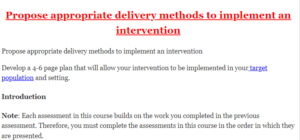Propose appropriate delivery methods to implement an intervention
Propose appropriate delivery methods to implement an intervention
Propose appropriate delivery methods to implement an intervention
Develop a 4-6 page plan that will allow your intervention to be implemented in your target population and setting.
Introduction
Note: Each assessment in this course builds on the work you completed in the previous assessment. Therefore, you must complete the assessments in this course in the order in which they are presented.
Even the best intervention plan will not be effective without a sound and reasonable approach to implementing it. The implementation of the same intervention plan can vary drastically between different care settings, based on the culture of the care setting, the resources available, and the stakeholders involved in the project, as well as the specific policies already in place. A successful implementation plan blends contemporary and emerging best practices and technology with an understanding of the on-the-ground realities of a specific care setting and the target population for an intervention. By synthesizing these various considerations it is possible to increase the likely success of the implementation and continued sustainability of an intervention plan.
Preparations
- Read Guiding Questions: Implementation Plan Design [DOC]. This document is designed to give you questions to consider and additional guidance to help you successfully complete this assessment.
- As you prepare to complete this assessment, you may want to think about other related issues to deepen your understanding or broaden your viewpoint. You are encouraged to consider the questions below and discuss them with a fellow learner, a work associate, an interested friend, or a member of your professional community. Note that these questions are for your own development and exploration and do not need to be completed or submitted as part of your assessment.
- What are the needs of your stakeholders that are relevant to your target population and need?
- What applicable health care policy and regulations are relevant to your target population and need?
- How will these considerations impact the development of your Intervention Plan Design assessment?
- How can you work these considerations into the development of your Implementation Plan Design assessment?
Instructions
Note: The assessments in this course are sequenced in such a way as to help you build specific skills that you will use throughout your program. Complete the assessments in the order in which they are presented.
Your implementation plan design will be the third section of your final project submission. The goal for this is to design a plan that will allow your intervention to be theoretically implemented in your target population and setting. You should be able to preserve the quality improvement outcomes that you designed for your target population and setting while also ensuring that the intervention does not put undue stress on the health care setting’s resources or violate any policies or regulations. Provide enough detail so that the faculty member assessing your implementation plan design will be able to provide substantive feedback that you will be able to incorporate into the final draft of your project.
At minimum, be sure to address the bullet points below, as they correspond to the grading criteria. You may also want to read the scoring guide and the Guiding Questions: Implementation Plan Design document (linked above) to better understand how each criterion will be assessed. In addition to the bullet points below, provide a brief introduction that refreshes the reader’s memory about your problem statement, as well as the setting and context for which this intervention plan was designed before launching into your implementation plan.
Reminder: these instructions are an outline. Your heading for this this section should be Management and Leadership and not Part 1: Management and Leadership.
Part 1: Management and Leadership
- Propose strategies for leading, managing, and implementing professional nursing practices to ensure interprofessional collaboration during the implementation of an intervention plan.
- Analyze the implications of change associated with proposed strategies for improving the quality and experience of care while controlling costs.
Part 2: Delivery and Technology
- Propose appropriate delivery methods to implement an intervention which will improve the quality of the project.
- Evaluate the current and emerging technological options related to the proposed delivery methods.
Part 3: Stakeholders, Policy, and Regulations
- Analyze stakeholders, regulatory implications, and potential support that could impact the implementation of an intervention plan.
- Propose existing or new policy considerations that would support the implementation of an intervention plan.
Part 4: Timeline
- Propose a timeline to implement an intervention plan with reference to specific factors that influence the timing of implementation.
Address Generally Throughout
- Integrate resources from diverse sources that illustrate support for all aspects of an implementation plan for a planned intervention.
- Communicate implementation plan in a way that clearly illustrate the importance of interprofessional collaboration to create buy-in from the audience.
Additional Requirements
- Length of submission: 4–6 double-spaced pages.
- Number of resources: 3–6 resources. (Your final project will require 12–18 unique resources.)
- Written communication: Written communication is free of errors that detract from the overall message.
- APA formatting: Resources and citations are formatted according to current APA style. Header formatting follows current APA levels.
- Font and font size: Times New Roman, 12 point.
Competencies Measured
By successfully completing this assessment, you will demonstrate your proficiency in the following course competencies and assessment criteria:
- Competency 1: Lead organizational change to improve the experience of care, population health, and professional work life while decreasing cost of care.
- Propose existing or new policy considerations that would support the implementation of an intervention plan.
- Competency 2: Evaluate the best available evidence for use in clinical and organizational decision making.
- Analyze stakeholders, regulatory implications, and potential support that could impact the implementation of an intervention plan.
- Competency 3: Apply quality improvement methods to impact patient, population, and systems outcomes.
- Propose appropriate delivery methods to implement an intervention which will improve the quality of the project.
- Integrate resources from diverse sources that illustrate support for all aspects of an implementation plan for a planned intervention.
- Competency 4: Design patient- and population-centered care to improve health outcomes.
- Propose a timeline to implement an intervention plan with reference to specific factors that influence the timing of implementation.
- Competency 5: Integrate interprofessional care to improve safety and quality and to decrease cost of care.
- Propose strategies for leading, managing, and implementing professional nursing practices to ensure interprofessional collaboration during the implementation of an intervention plan.
- Evaluate the current and emerging technological options related to the proposed delivery methods.
- Competency 6: Evaluate the ability of existing and emerging information, communication, and health care technologies to improve safety and quality and to decrease cost.
- Analyze the implications of change associated with proposed strategies for improving the quality and experience of care while controlling costs.
Note: You will also be assessed on two additional criteria unaligned to a course competency:
- Communicate implementation plan in a way that clearly illustrates the importance of interprofessional collaboration to create buy-in from the audience.
Grading Scale:
1- Propose strategies for leading, managing, and implementing professional nursing practices to ensure interprofessional collaboration during the implementation of an intervention plan.
Passing Grade: Proposes strategies for leading, managing, and implementing professional nursing practices to ensure interprofessional collaboration during the implementation of an intervention plan, and impartially considers conflicting data and other perspectives.
2- Analyze the implications of change associated with proposed strategies for improving the quality and experience of care while controlling costs.
Passing Grade: Analyzes the implications of change associated with proposed strategies for improving the quality and experience of care while controlling costs; identifies knowledge gaps, unknowns, missing information, unanswered questions, or areas of uncertainty (where further information could improve the analysis).
3- Propose appropriate delivery methods to implement an intervention which will improve the quality of the project.
Passing Grade: Proposes appropriate delivery methods to implement an intervention which will improve the quality of the project, and identifies assumptions on which the proposal of delivery methods is based.
4- Evaluate the current and emerging technological options related to the proposed delivery methods.
Passing Grade: Evaluates the current and emerging technological options related to the proposed delivery methods; identifies knowledge gaps, unknowns, missing information, unanswered questions, or areas of uncertainty (where further information could improve the analysis).
5- Analyze stakeholders, regulatory implications, and potential support that could impact the implementation of an intervention plan.
Passing Grade: Analyzes stakeholders, regulatory implications, and potential support that could impact the implementation of an intervention plan, and identifies assumptions on which the analysis is based.
6- Propose existing or new policy considerations that would support the implementation of an intervention plan.
Passing Grade: Proposes existing or new policy considerations that would support the implementation of an intervention plan, and considers how existing or new policy might impair the implementation of an intervention plan.
7- Propose a timeline to implement an intervention plan with reference to specific factors that influence the timing of implementation.
Passing Grade: Proposes a timeline to implement an intervention plan with reference to specific factors that influence the timing of implementation, and considers factors that could force revision of the timeline.
8- Integrate resources from diverse sources that illustrate support for all aspects of an implementation plan for a planned intervention.
Passing Grade: Integrates resources from diverse sources that illustrate support for all aspects of an implementation plan for a planned intervention; impartially considers conflicting data and other perspectives.
9- Communicate implementation plan in a way that clearly illustrates the importance of interprofessional collaboration to create buy-in from the audience.
Passing Grade: Communicates implementation plan in a way that clearly illustrates the importance of interprofessional collaboration to create buy-in from the audience. Grammar, punctuation, spelling, and citations are error-free.
Use the following coupon code :
NursesHomework


